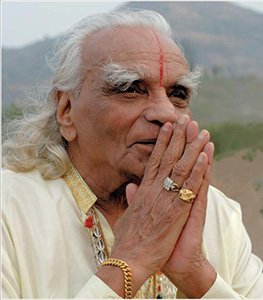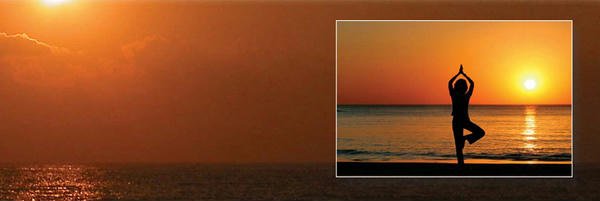
 t is never too late in life to practice yoga. If it were, then I should have stopped my practice long ago. Why should I do so now? Many Indian yogis reach a certain point in their lives and say they have reached samadhi, so they don’t need to practice anymore. But I have not said that up to now. Why not? Learning is a delight, and there are many delights to be obtained through the practice of yoga. But I am not doing it for delight! In the early days delight was the aim, but now it is a by product. The sensitivity of intelligence which has been developed should not be lost. That is why the practice has to continue.
t is never too late in life to practice yoga. If it were, then I should have stopped my practice long ago. Why should I do so now? Many Indian yogis reach a certain point in their lives and say they have reached samadhi, so they don’t need to practice anymore. But I have not said that up to now. Why not? Learning is a delight, and there are many delights to be obtained through the practice of yoga. But I am not doing it for delight! In the early days delight was the aim, but now it is a by product. The sensitivity of intelligence which has been developed should not be lost. That is why the practice has to continue.
If you have a knife which you do not use, what happens to it? It gets rusted, does it not? If you want to go on using it, you have to sharpen it regularly. With regular sharpening, you can keep it sharp forever. Similarly, having experienced samadhi once, how do you know that you are going to remain alert and aware forever? How can you say that you can maintain it without practice? You may forget, and go back to enjoying your life in the same way as you did before. Can a dancer or concert performer give a fine performance if they have not practiced for a year? It is the same for a yogi. Though one may have reached the highest level, the moment one thinks one has reached the goal and that no practice is required, one becomes unstable. In order to maintain stability, practice has to continue. Sensitivity requires stability. It has to be maintained by regular practice.
You may be fifty years old, or sixty years old, and ask yourself whether it is too late in life to take up yoga practice. One part of the mind says, “I want to go ahead,” and another part of the mind is hesitating. What is that part of the mind which is hesitating? Perhaps it is fear. What produces that fear? The mind is playing three tricks. One part wants to go ahead, one wants to hesitate, and one creates fear. The same mind is causing all three states. The trunk is the same, but the tree has many branches. The mind is the same, but the contents of the mind are contradictory. And your memory also plays tricks, strongly reacting without giving a chance to your intelligence to think.
Life is swimming, and death is sinking. If you know these two, then there is no fear. Because we don’t want to know them, fear comes. But why should I not face death happily? Fear says that as you get older, diseases and suffering increase. Your mind says you should have done yoga earlier, or you should have continued and not stopped in your youth. Now you say you are very old and perhaps it is too late, so you hesitate. It is better just to start, and when you have started, maintain a regular rhythm of practice.
At a certain age the body does decay, and if you do not do anything, you are not even supplying blood to those areas where it was being supplied before. By performing asanas we allow the blood to nourish the extremities and the depths of the body, so that the cells remain healthy. But if you say, “No, I am old,” naturally the blood circulation recedes. If the rains don’t come, there is drought and famine, and if you don’t do yoga—if you don’t irrigate the body—then when you get drought or famine in the body as incurable diseases; you just accept them and prepare to die.
Why should you allow the drought to come when you can irrigate the body? If you could not irrigate it at all, it would be a different matter. But when it is possible to irrigate, you should surely do so. Not to do so allows the offensive forces to increase and the defensive forces to decrease. Disease is an offensive force; inner energy is a defensive force. As we grow, the defensive strength gets less and the offensive strength increases. That is how diseases enter into our system. A body which carries out yogic practice is like a fort which keeps up its defensive strength so that the offensive strength in the form of diseases will not enter into it through the skin. Which do you prefer? Yoga helps to maintain the defensive strength at an optimum level, and that is what is known as health.
Much has been said by certain people about the dangers of yoga, and the risk of injury. But if you walk in the street carelessly, you can have an accident. So do you advise people not to walk? People die when they are in bed. So is it dangerous to sleep on a bed?
I have been doing yoga for over fifty years, and have taught many thousands of students in the five continents of this globe. Sadly, there are teachers of yoga who know very little and claim to teach. The problem comes not from the art of yoga, but from the inexperience of the teachers, and also from the impatience of the pupils. If a person who cannot stand tries to walk, he will break his legs, and so it is in yoga. In Western countries particularly, people want above all to do padmasana, the lotus pose. They say, “I think I can do it!” Unfortunately, the thinking is in the head, but the doing is in the knee! If you do not understand the intelligence of the knee and you force it to follow your brain, then the knee will break. But if you understand the stiffness as well as the mobility of the knee, and go step by step to remove the stiffness and increase the range of mobility, then there is no danger at all. If there are accidents in yoga, it is not the fault of yoga, but of the aggressiveness of the pupil who does it.
So you can all do yoga. The queen of Belgium started doing head-balance at the age of eighty-six. Nothing happened to her. I hope there will be no confusion about what I am saying. You can do it, but do it judiciously, knowing your capacity. If you try to imitate me, naturally you will suffer, because I have been doing it for half a century. You have to wait to reach that level. Yoga cannot be rushed.
From The Tree of Yoga, by B. K. S. Iyengar, © 1988. Reprinted by arrangement with Shambhala Publications Inc., Boston, MA. www.shambhala.com.
http://www.shambhala.com/html/catalog/items/isbn/978-1-57062-901-3.cfm

Hatha Yoga’s Effects on Aging
Live longer. Yoga affects all the important determinants of a long life: the brain, glands, spine and internal organs.
Increased resistance to disease. Yoga produces a healthy strong body with increased immunity. This increased resistance extends from the common cold to serious diseases like cancer.
Increased vitality. Increased vitality due to yoga’s effect on the brain and glands.
Rejuvenation of the glands. Yoga has a marked effect on the pituitary, thyroid, adrenal and sex glands. This produces a feeling of well-being, prevents premature aging and extends vitality and virility well into old age.
Look and feel younger. Yoga reduces facial wrinkles and produces a natural ‘face-lift’. This is mainly due to the inverted postures. By doing the inverted postures for a few minutes each day, we reverse the effect of gravity and use it to our advantage.
Vision and hearing improve. Normal vision and hearing depend to a large extent on the eyes and ears receiving a good nerve and blood supply. The nerves and blood vessels which supply the eyes and ears have to pass through the neck. As we get older, the neck becomes less flexible. Yoga postures and yoga neck exercises improve the condition of the neck, resulting in better eyesight and improved hearing.
Mental/emotional benefits. Because of yoga’s rejuvenation effects on the glands and nervous system, including the brain, yoga results in a positive mental/emotional state.


